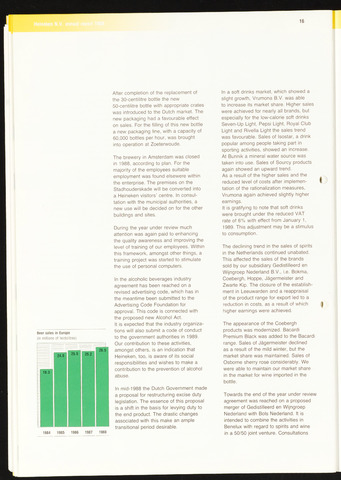16
Beer sales in Europe
(in millions of hectolitres)
r
19.3
24.8
25.5
25.2
26.5
1984 1985 1986 1987 1988
After completion of the replacement of
the 30-centilitre bottle the new
50-centilitre bottle with appropriate crates
was introduced to the Dutch market. The
new packaging had a favourable effect
on sales. For the filling of this new bottle
a new packaging line, with a capacity of
60,000 bottles per hour, was brought
into operation at Zoeterwoude.
The brewery in Amsterdam was closed
in 1988, according to plan. For the
majority of the employees suitable
employment was found elsewere within
the enterprise. The premises on the
Stadhouderskade will be converted into
a Heineken visitors' centre. In consul
tation with the municipal authorities, a
new use will be decided on for the other
buildings and sites.
During the year under review much
attention was again paid to enhancing
the quality awareness and improving the
level of training of our employees. Within
this framework, amongst other things, a
training project was started to stimulate
the use of personal computers.
In the alcoholic beverages industry
agreement has been reached on a
revised advertising code, which has in
the meantime been submitted to the
Advertising Code Foundation for
approval. This code is connected with
the proposed new Alcohol Act.
It is expected that the industry organiza
tions will also submit a code of conduct
to the government authorities in 1989.
Our contribution to these activities,
amongst others, is an indication that
Heineken, too, is aware of its social
responsibilities and wishes to make a
contribution to the prevention of alcohol
abuse.
In mid-1988 the Dutch Government made
a proposal for restructuring excise duty
legislation. The essence of this proposal
is a shift in the basis for levying duty to
the end product. The drastic changes
associated with this make an ample
transitional period desirable.
In a soft drinks market, which showed a
slight growth, Vrumona B.V. was able
to increase its market share. Higher sales
were achieved for nearly all brands, but
especially for the low-calorie soft drinks
Seven-Up Light, Pepsi Light, Royal Club
Light and Rivella Light the sales trend
was favourable. Sales of Isostar, a drink
popular among people taking part in
sporting activities, showed an increase.
At Bunnik a mineral water source was
taken into use. Sales of Sourcy products
again showed an upward trend.
As a result of the higher sales and the
reduced level of costs after implemen
tation of the rationalization measures,
Vrumona again achieved slightly higher
earnings.
It is gratifying to note that soft drinks
were brought under the reduced VAT
rate of 6% with effect from January 1
1989. This adjustment may be a stimulus
to consumption.
The declining trend in the sales of spirits
in the Netherlands continued unabated.
This affected the sales of the brands
sold by our subsidiary Gedistilleerd en
Wijngroep Nederland B.V., i.e. Bokma,
Coebergh, Hoppe, Jagermeister and
Zwarte Kip. The closure of the establish
ment in Leeuwarden and a reappraisal
of the product range for export led to a
reduction in costs, as a result of which
higher earnings were achieved.
The appearance of the Coebergh
products was modernized. Bacardi
Premium Black was added to the Bacardi
range. Sales of Jagermeister declined
as a result of the mild winter, but the
market share was maintained. Sales of
Osborne sherry rose considerably. We
were able to maintain our market share
in the market for wine imported in the
bottle.
Towards the end of the year under review
agreement was reached on a proposed
merger of Gedistilleerd en Wijngroep
Nederland with Bols Nederland. It is
intended to combine the activities in
Benelux with regard to spirits and wine
in a 50/50 joint venture. Consultations

